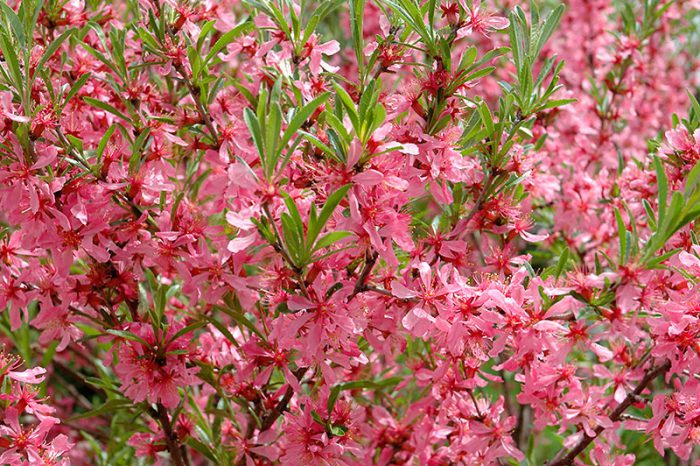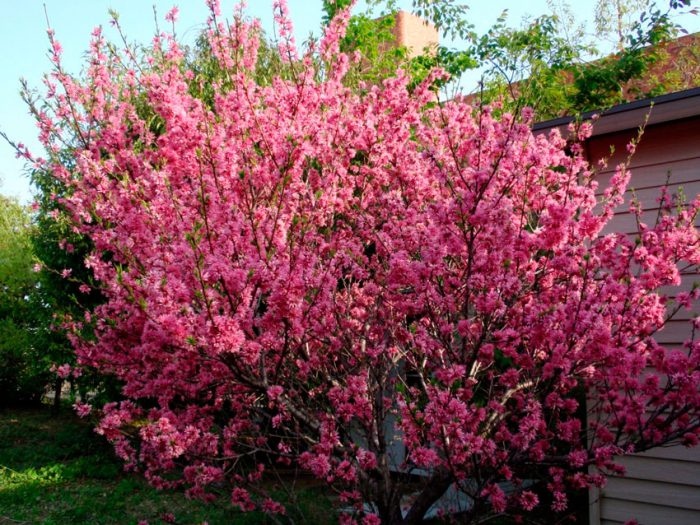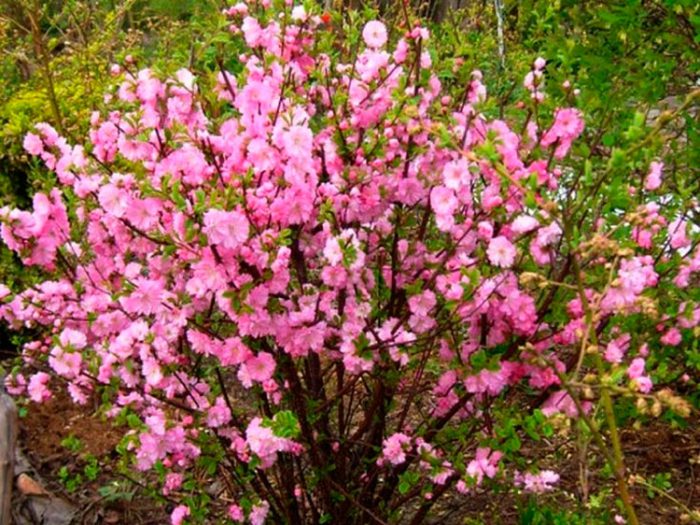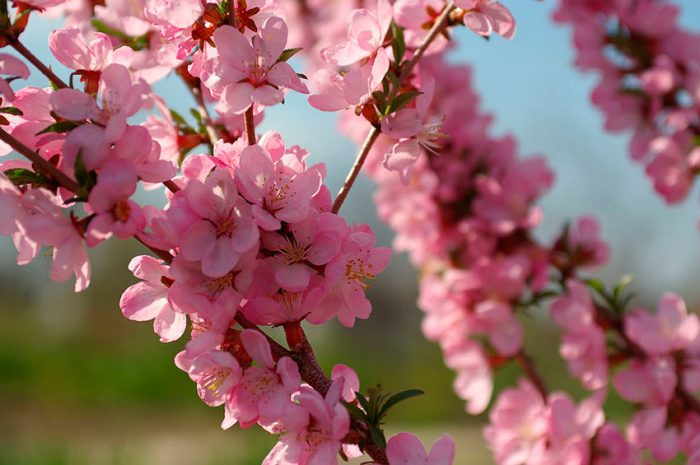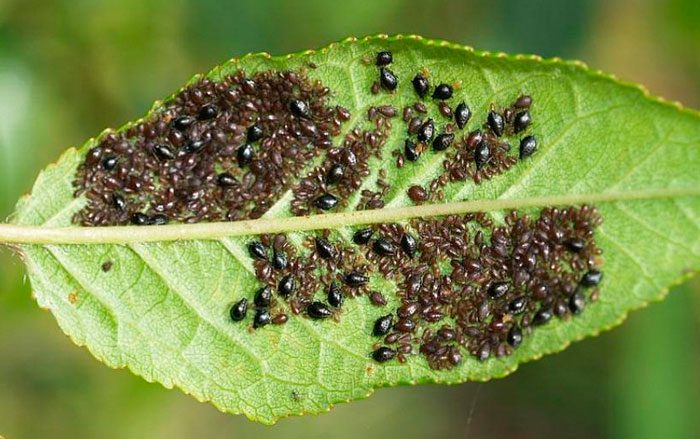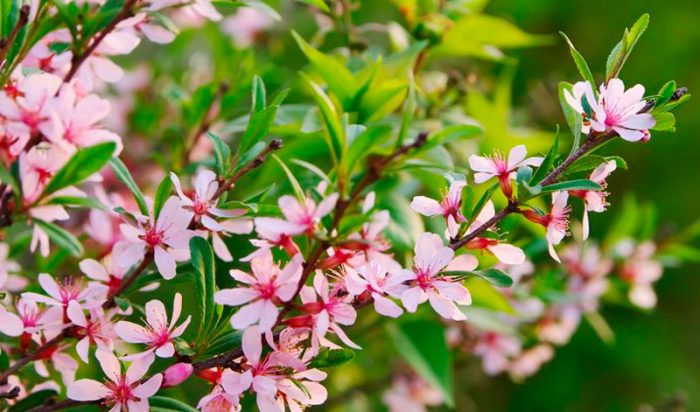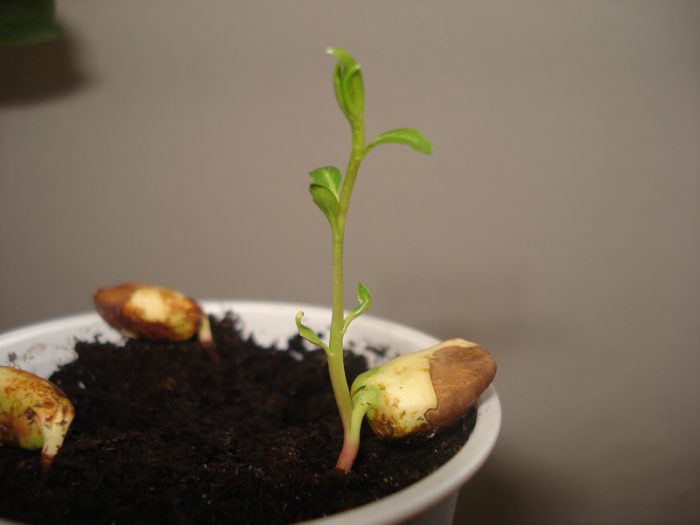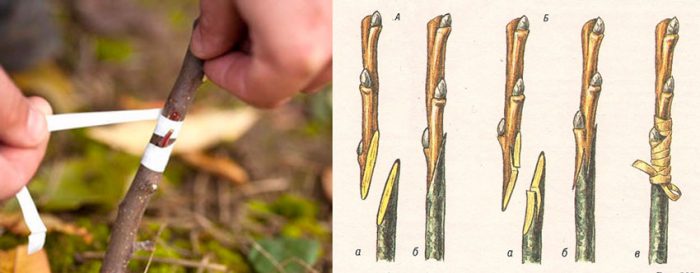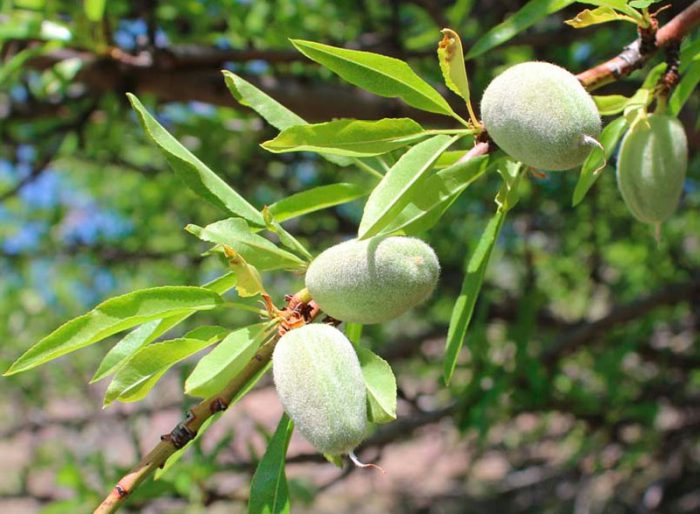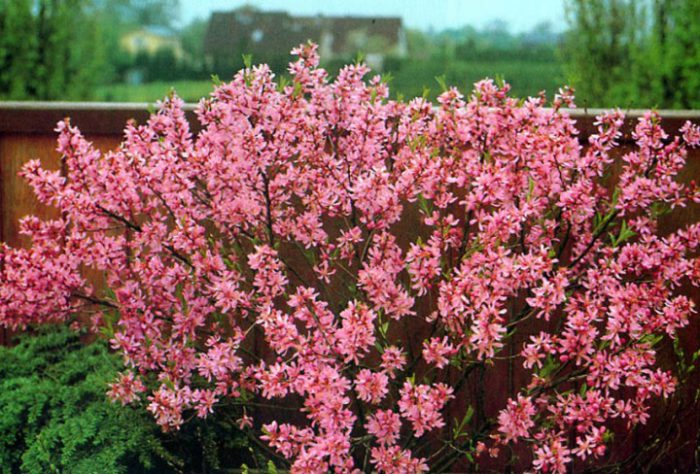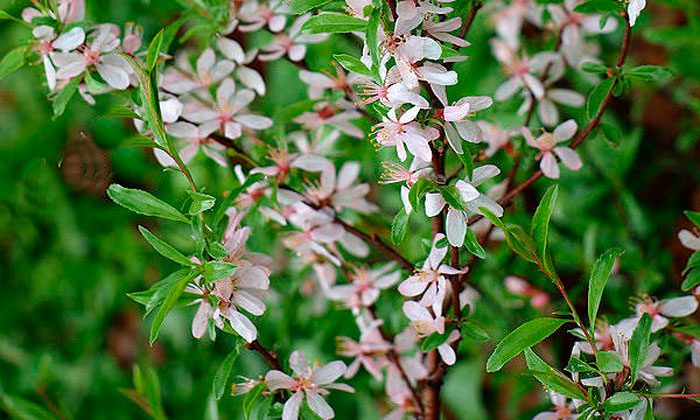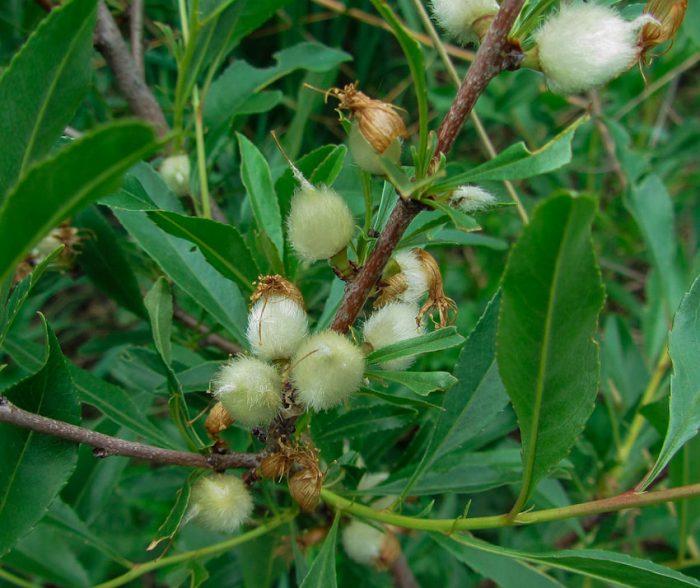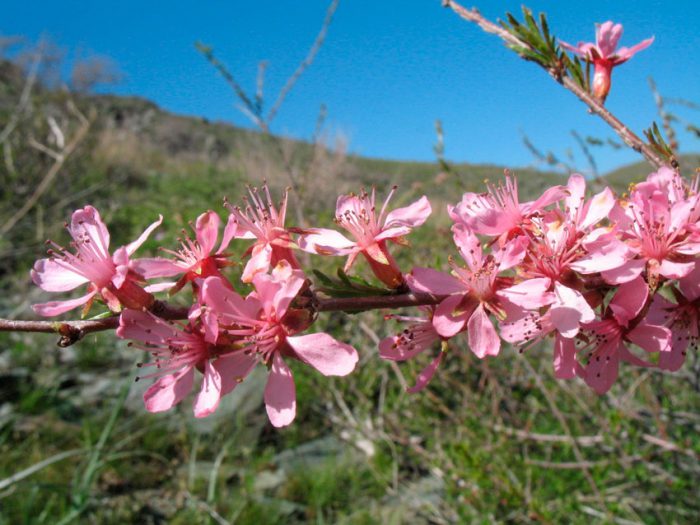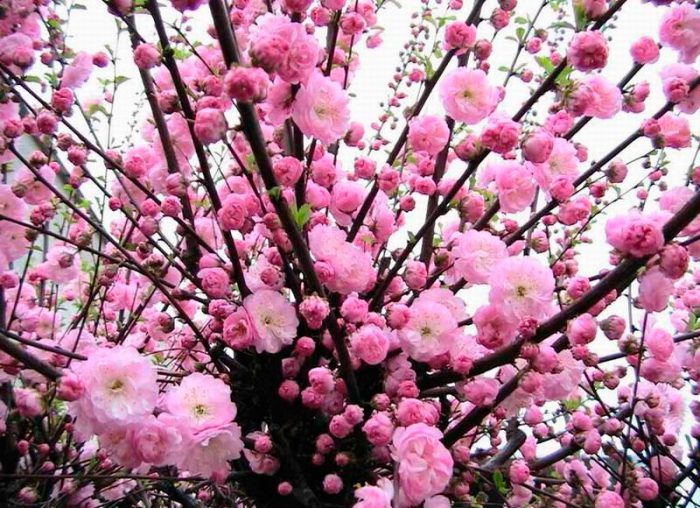Almond is a shrub or tree. Such a plant belongs to the subgenus almond of the genus plum of the pink family. It is very often mistaken for a nut, although it is actually a stone fruit. Almonds grew in Central Asia and the Mediterranean for several centuries BC. Today it can be found in California, Czech Republic, China, Slovakia, as well as South Moravia. This light-loving plant is highly resistant to drought. Under natural conditions, such a culture prefers to grow in small groups (several pieces of bushes or trees) at an altitude of 800-1600 meters above sea level. In Russia, common almonds are grown in the southern zone of the European part. In the middle latitudes, steppe almonds, or bean, or low almonds, or tender plums are cultivated. This type of such a plant has not only valuable fruits, but also very beautiful leaves and flowers. At the same time, the three-lobed almond is considered the most decorative species in such a culture; it is usually cultivated as an ornamental plant. Below will be described in detail how to plant and grow an ornamental almond shrub.
Content
Features of decorative almonds
Almonds, an ornamental shrub, can grow in height from 250 to 300 centimeters. There is nothing difficult in growing such a shrub; even a novice gardener can cope with this. It is one of the most valuable decorative crops. There are varieties that grow on a trunk, outwardly this shrub is similar to an almond tree, it has leathery lanceolate leaf plates of dark green color with a serrated edge, a compact crown has a spherical shape. The flowering of decorative almonds can only be seen 4 or 5 years after it is planted in the garden. Double or simple, very showy flowers with many stamens and petals can be painted white or pink. Flowering, as a rule, lasts about 20 days, while the bush seems to be shrouded in flowers, like an air cloud.It is enough to see such a shrub in bloom once to remember this wonderful sight for a lifetime. Leaf blades usually grow back after flowering ends. You can't eat ornamental almonds, but they are just as incredibly beautiful. The fruit is a three-lobed suede pericarp with a rounded shape, inside it has a bone, which is very easy to separate.
This plant is in a very close relationship with such fruit crops as: cherry, bird cherry, cherry plum, nectarine, sakura, plum, sweet cherry, apricot, peach and blackthorn. And it is also related to apple, rose hips, hawthorn, mountain ash, pear, quince, rose and chokeberry.
Ornamental almonds are not picky about growing conditions, are highly resistant to drought and are considered a very valuable honey plant. If the shrub is well looked after, then it can live for 100 years or more. Ornamental almonds differ from ordinary almonds (cultivated in most cases only for the sake of fruit) in that they have a very high frost resistance and grow well in mid-latitudes. That is why almonds are no longer a rarity in Siberia.
Planting almonds
What time to plant almonds
It is recommended to plant decorative almonds in the autumn after the leaf fall is over. It can also be carried out in early spring, after the night frosts have passed and warm weather has been established. It should be borne in mind that the autumn planting for such a plant is more preferable.
Saline or acidic soil is not suitable for cultivating this shrub, a suitable soil pH should be between 4.5 and 7.5. You should also choose an area where the groundwater is not close to the soil surface. For growing this shrub, it is recommended to choose an area with light sandy loam or loamy soil, saturated with nutrients. At the same time, in clayey heavy soil, almonds will quickly die. This shrub needs a lot of sunlight and air, therefore it is recommended to plant it in the southern side of the garden plot. The place where the plant will be planted can be illuminated by the sun all day, or it will be covered by the shade from nearby trees for no more than three hours.
How to plant
Ornamental almonds need cross-pollination, therefore it is recommended to plant several bushes of this beautiful plant at once. Mostly bees are involved in pollination of almonds, in this regard, it will be simply excellent if a small apiary is located not very far from these shrubs.
From the area where the almonds will be planted, it is necessary to remove all plants that can cast a relatively large shadow. At the same time, it is not necessary to remove stones, because in natural conditions this shrub prefers to grow on rocky slopes. The depth of the planting hole must be at least 30 centimeters. In this case, the distance between the specimens should be from 3 to 5 meters, and the row spacing should be about 5 meters. Make a drainage layer at the bottom of the planting hole, for this it is recommended to use crushed stone or broken brick, and a layer of sand is laid on top of it. Then, in the middle of the bottom of the pit, you need to drive a long pole, which will support the seedling, while it is necessary that it rise above the surface of the site by at least 50 centimeters.
Directly planting the bush should be done very early in the morning or after 4 pm. Before you start planting annual seedlings, their root system needs to be immersed for a while in a clay talker. Then they are lowered into the planting holes and covered with a soil mixture consisting of an upper nutrient layer of soil, sand and humus, while the root neck of the plant must necessarily rise above the surface of the site by a couple of centimeters. In the event that the soil is acidic, it will need to be mixed with a small amount of dolomite flour or lime. Upon completion of planting, the soil will need to be well tamped, and the plants will need to be watered (for 1 bush from 10 to 15 liters of water).After the liquid is completely absorbed, and the earth settles at the same time, it will be necessary to tie the bush to the previously installed support, and also fill the trunk circle with a layer of mulch (peat or dry soil). It is necessary to make sure that the root collar, which after watering should be flush with the surface of the site, is free of mulch.
Care features
Planting and growing almonds is easy enough and won't pose any particular problems for the grower. You need to take care of it in the same way as for the rest of the ornamental shrubs, namely: water, weed, cut, loosen the soil, feed, treat diseases and harmful insects on time.
Water the almonds so that the surface of the trunk circle never dries out. However, it should be borne in mind that stagnant water in the soil can cause rot formation on the root collar of the bush. Watering is carried out approximately 1 time in 7 days, while the soil should dry out a couple of centimeters in depth. 10 liters of water are poured under 1 bush. Experienced gardeners recommend, after each watering, loosen the soil surface around adult bushes from 8 to 10 centimeters deep, and around young ones - from 5 to 7 centimeters. Weeding should also be done during loosening.
In order for the plant to grow and develop normally, it needs feeding. In spring, it is recommended to sprinkle the trunk circle with mulch, but instead of peat, take mullein or manure. A short time later, under each shrub, it will be necessary to pour a nutrient solution consisting of 10 liters of water, 20 grams of ammonium nitrate and 10 grams of urea. In autumn, 20 grams of double superphosphate and the same amount of potassium sulfate will need to be added to each square meter of the plot.
Almond pruning
Ornamental shrub almonds need timely pruning. Spring pruning should be carried out before sap flow begins, while all injured, frostbitten, dried, thickening crown and disease-damaged branches and shoots should be removed. It happens that one of the branches interferes with the normal growth of the other, they are called competing. In this case, the strongest and most well-located branch is chosen, and the second is cut off. After the almonds have bloomed, formative pruning is performed. Cutting does not harm this plant, on the contrary, if you cut off the faded stems in a timely manner, then next year the almonds will bloom even more magnificently.
After the bush turns 7 years old, it will be necessary to remove those branches that have become very old. They can be replaced by root suckers, which grow after the bush turns 3 years old.
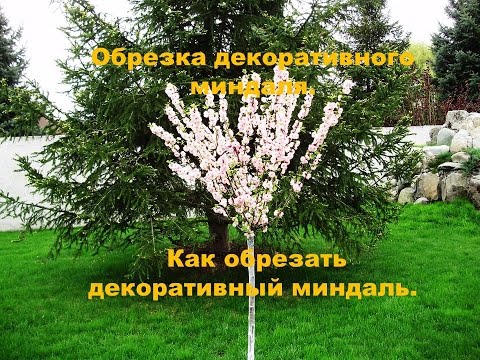

Watch this video on YouTube
How almonds bloom
There are sources claiming that the name almond comes from the word amygdalos, which is translated from ancient Greek as "beautiful tree". Many consider this version to be true, since blooming almonds look just bewitchingly beautiful. There are so many flowers that they stick around the whole plant. Their color can be red, pink, white or purple. Those who love painting have probably seen the painting "Blooming Almond Branches" by Vincent van Gogh.
If the region has a rather warm and mild climate, then almonds begin to bloom in the last days of January, and ends in March. In mid-latitudes, flowering begins in the last days of April or the first days of May and lasts about half a month. At this time, the shrub must receive the required amount of water, otherwise the flowering will not be so long.
Diseases and pests
Almonds are susceptible to diseases such as moniliosis, scab, clotterosporia, gray rot and rust. And from pests, aphids, almond seed-eaters, spider mites and leaf rollers can settle on it. Fungal diseases can be dealt with with fungicides, for example: Skorom, Cuproxat, Topaz, Fundazol.They get rid of pests with the help of insecticides: Calypso, Zolon, Actellik or Fufanon. And if a spider mite has settled on a bush, then it should be treated with Akarin, Kleschevite or Agravertin.
However, it should be remembered that if you take care of this ornamental shrub correctly, then you will very rarely have problems with it.
Wintering
Preparing for winter
For wintering, this shrub must begin to prepare in the summer. So, for this, the tops of the stems are printed, due to which they lignify much faster, and the almonds do not freeze in winter. Young seedlings must be covered in autumn with dried foliage, straw or lutrasil, to a height of 15 centimeters from the ground surface. It is necessary to ensure that the root collar under a layer of snow does not start to rot. Adult specimens do not need shelter for the winter. If part of the stems freezes, then the shrub in the spring is restored in a short time.
Wintering in the suburbs and Moscow
In Moscow and the Moscow region, it is recommended to grow such types of almonds as: low (steppe), Georgian, three-lobed and Ledebour almonds. These shrubs may suffer a little during the wintering period from severe frost, however, they recover very quickly and bloom incredibly abundantly. You need to plant and care for almonds in the same way as they do in the middle lane (described above).
Almond propagation
Varietal almonds can only be propagated by layering, grafting and shoots, and species almonds can also be propagated by seeds. Some gardeners grow rootstocks on their own, and then they are grafted with varietal cuttings.
Growing almonds from seeds
Seeds are sown in open ground, and this can be done in spring or autumn. It should be noted that before you start sowing in the spring, the seeds should be prepared, for this they are placed in the refrigerator for four months on a vegetable shelf. Make grooves in the soil, the depth of which should be from 8 to 10 centimeters, while keeping a distance of 10 to 12 centimeters between the seeds. The gap between the grooves should be 50 centimeters. The almond seedlings that appear require care, which consists in timely watering, weeding and loosening the soil surface. In the summer, when the seedling reaches half a meter in height, and the thickness of its stem is 10 mm, all its branches that grow up to 10 centimeters from the root collar must be cut into a ring. Then the plants are transplanted to a permanent place. As soon as they get sick, you can start grafting varietal cuttings on them.
Almond grafting
Rootstocks of any of the species of this plant are suitable for grafting, but it is recommended to take those of them that are highly frost-resistant. Almonds grow well on rootstocks of cherry plum, bird cherry, blackthorn or plum. A suitable graft must be straight, have well-developed stems with eyes that must be fully formed. All foliage should be removed from the cutting with a pruner, only short centimeter-long petioles should be left.
This shrub can be propagated by grafting only at a time when sap flow is observed, namely: in spring or in August. The rootstock, which should grow in open ground, should be gently wiped with a damp cloth, thereby removing dust and dirt from it. Then, a little above the root collar, a T-shaped incision must be made using an eyepiece knife. And then gently turn the incised bark to the sides. A scute should be cut off from the scion, which is a strip of bark with a bud and a thin layer of wood. It should be noted that the flap should fit entirely into the T-cut you made earlier, so you do not need to make it too long. When the flap is inserted, press the edges of the bark that were previously unfolded.To fix the shield, you can use an eyepiece tape, tape or a plaster, while it is enough to make just a few turns around the stem. At the same time, remember that the bud with the remainder of the stem should not be closed.
If the vaccination was carried out in the spring, then after half a month the petiole from the bud, which should still be green, should fall off by itself, while the eyepiece tape should be slightly loosened. In the event that the grafting was carried out in August, then the tape should not be removed until the next autumn period, while in late autumn the grafted seedling must be spud with soil (the grafting site must be covered with earth). With the onset of spring, the soil must be removed so that the root collar is free, and the fixing tape is also removed.
Cuttings
Planting material for cuttings should be prepared from mid to late June. For this, semi-lignified apical cuttings are cut, on which there should be 2 nodes, their length varies from 15 to 20 centimeters. Then the cuttings must be immersed in a growth stimulating agent for 16 hours. They should be rooted in a cold greenhouse. For planting, a soil mixture consisting of peat and sand (2: 1) is used. Cuttings will take root completely after 20-30 days. According to statistics, 85-100 percent of cuttings take root. When the roots appear, the cuttings will need to be transplanted into a training bed for growing.
How to propagate by growth
Strong pruning should be done to provoke active growth around the shrub. The detached offspring must have a fully formed root system, and this will happen only in the second year. The offspring transplanted to a permanent place should be looked after in the same way as for a one-year-old seedling.
How to propagate by layering
It is necessary to bend flexible stems to the soil surface, fix them with metal studs, and then sprinkle them with earth. During that time, while the root system is forming at the layers, they should be provided with timely watering, weeding and loosening of the soil surface. It will be possible to separate the layers and plant it in a permanent place only after 12 months. During this time, the root system should be fully formed.
Types and varieties of almonds with photos
Common almonds
This species is grown as a fruit plant. It is divided into sweet almonds, which are cultivated by many gardeners and do not contain any harmful substances in their fruits, as well as wild almonds (bitter) - there is hydrocyanic acid in its cores. A large number of sweet almond varieties are very popular among gardeners and are also grown on an industrial scale. This type of almond is not decorative, but its fruit has a high healing and nutritional value.
Low almonds, either steppe or bean
The height of this deciduous shrub can be up to 150 centimeters. Its lush crown has a spherical shape, the bark on upright branches is gray-reddish. The length of leathery narrow lanceolate leaf plates is about 6 centimeters. The front surface is dark green, and the back is pale green. Single flowers have a deep pink color. Blooms for 1–1.5 weeks. The fruit of such a shrub can be eaten. This type is very popular with gardeners in the middle lane. This species has 2 forms, namely: white-flowered and Gessler. Gessler's almond is smaller than the original species, but its deep pink flowers are somewhat larger. In the middle lane, the following varieties are most popular:
- White sail... White flowers of a centimeter diameter densely cover the branches of the plant.
- Anyuta... The deep pink flowers have a diameter of about 2.5 centimeters.
- Dream... The diameter of the light pink flowers is about 2.5 centimeters.
- Pink flamingo... The diameter of the double pink flowers reaches 1 centimeter.
- Pink fog... Quite large, deep pink flowers have a diameter of about 2.5 centimeters.
- Mediator... This variety was created by Michurin. As a rule, such a tree reaches a height of 200 centimeters, its large flowers are light pink in color. The plant is highly frost-resistant.
Georgian almonds
This Caucasian endem prefers to grow on forest edges, elephants, and also in hollows. The bush reaches a height of about 100 centimeters, outwardly it bears great resemblance to low almonds, however, its leaf plates are not so small and reach about 8 centimeters in length, and the bristly deep pink flowers are larger in size. This species is especially often used in their work by breeders, and it can also be grown in the conditions of the Moscow region, since it is quite frost-resistant.
Ledebour almond
In natural conditions, it can be found in the foothills of Altai, while this species can form dense thickets. Large leaf plates are dark green in color. Flowering begins earlier than in other species and lasts 15–20 days. The flowers are pink. The most famous variety is Fire Hill, its pink-red flowers can reach 30 mm in diameter.
Almond Petunnikov
This species is endemic to Central Asia. The height of this shrub reaches 100 centimeters, the branches are spread out or erect, covered with brown-gray bark. Shoots are pale yellow. Lanceolate or linear leaf plates have a pointed upper part and a blunt-serrated edge. Single pink flowers.
Three-lobed almond
This shrub has a spreading crown, and in height it can reach 300 centimeters. Three-bladed sheet plates with a coarse toothed edge have a very fuzzy back surface during opening. In diameter, the flowers reach 1.5 centimeters, on the stems they are located in pairs, can be painted in different colors. There are 2 decorative shapes:
- Captivity... The diameter of the double pink flowers is from 3 to 4 centimeters. Flowering begins after the leaf plates appear, which reduces the decorativeness of the plant itself.
- Kievskaya... The bush can reach a height of 350 centimeters, the flowering is very lush. The double pink flowers range in diameter from 2.5 to 3.5 centimeters. The leaves appear later than the opening of the flowers, due to which the plant has high decorative qualities.
This species has a large number of hybrids and varieties that differ not only in color and size of flowers, but also in flowering period, for example:
- Svitlana... This variety was created by breeders from Ukraine. The flowers are very light.
- Tanyusha... The diameter of the double flowers is from 25 to 35 mm, the petals are swirling.
- Snows of Wimura... Terry large enough flowers have a light pink color, which, after the plant begins to fade, changes to cream.
- In memory of Makhmet... The color of the double flowers is flesh pink.
- Chinese... The flowers are simple, pale pink.
- Ruslana... This variety is hybrid. The color of simple flowers is flesh, and when the plant begins to fade, it changes to almost white.
- Hybrid No. 3... Large double light pink flowers are placed on long peduncles. The flowering of this plant is similar to sakura.
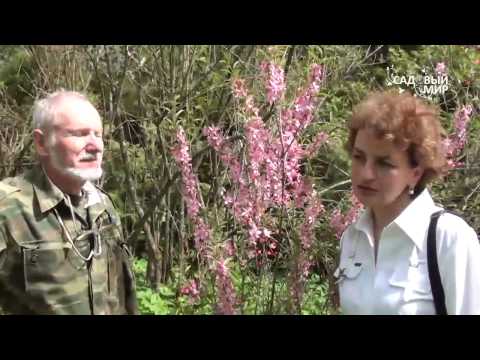

Watch this video on YouTube

